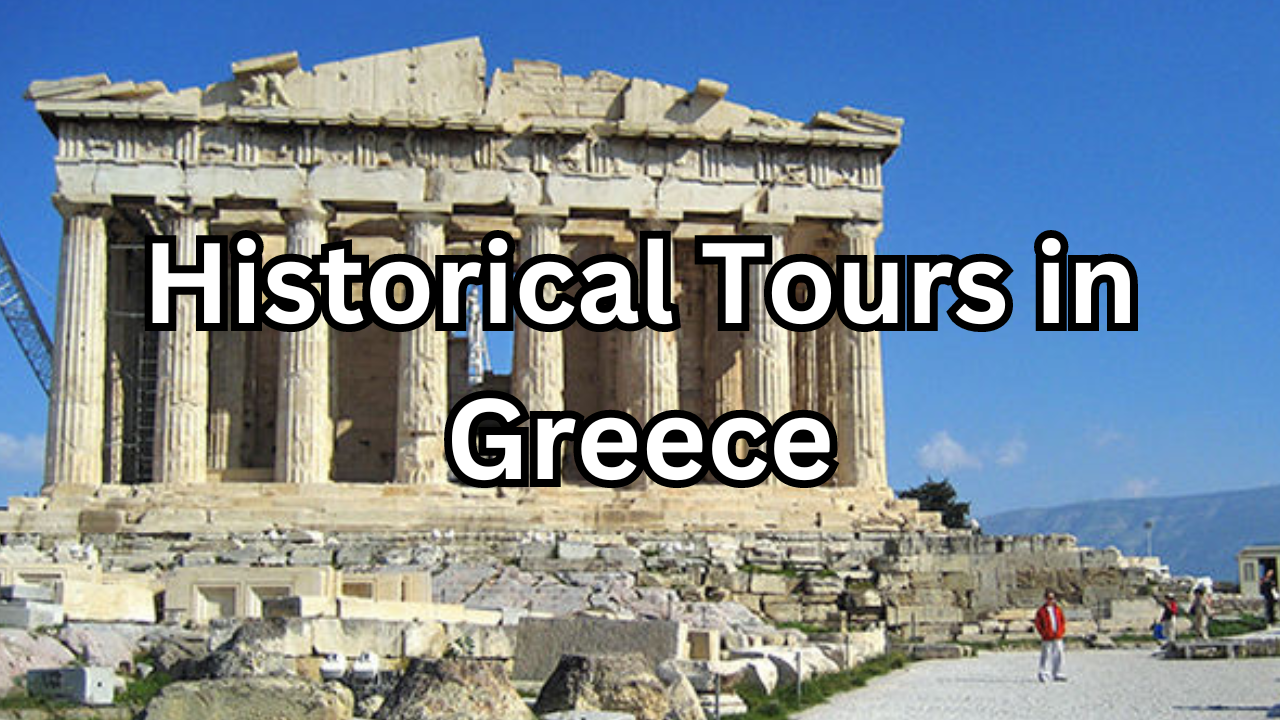Table of Contents
Introduction:
Greece, a land steeped in mythology, ancient civilizations, and cultural heritage, offers a wealth of historical tours that unveil its captivating past. These tours not only transport visitors to millennia-old sites but also provide a profound understanding of historical tours in Greece influence on Western civilization. From the majestic Acropolis in Athens to the mystical ruins of Delphi and the ancient wonders of Crete and Santorini, each historical tour in Greece is a journey through time, weaving together myths, legends, and historical facts. Join us as we embark on an exploration of the fascinating historical tours that bring Greece’s rich heritage to life.
Brief Overview of Historical Tours in Greece Heritage:
Greece stands as a living testament to a civilization that has shaped the course of human history in Europe. Its heritage spans thousands of years, encompassing the birth of democracy, the rise of philosophy, the glory of ancient architecture, and the enduring legacy of mythology. From the heights of Mount Olympus, home of the gods, to the ruins of ancient cities like Athens, Sparta, and Corinth, Greece’s landscape is dotted with remnants of a bygone era. The country’s history is woven with tales of heroes, scholars, artists, and statesmen whose contributions resonate through time.
Importance of Historical Tours for Understanding Greece’s Past:
Historical tours serve as gateways to unlock the mysteries and marvels of Greece’s past. They provide immersive experiences that go beyond textbooks and lectures, allowing travelers to walk in the footsteps of ancient Greeks, Romans, Byzantines, and Ottomans. These tours offer insights into the daily life, customs, beliefs, and achievements of ancient civilizations, fostering a deeper appreciation for Greece’s cultural heritage. By visiting archaeological sites, museums, and historical landmarks, participants gain firsthand knowledge of the historical context, artistic achievements, and societal structures that shaped Greece’s evolution. Moreover, historical tours promote cultural preservation and heritage conservation, ensuring that Greece’s rich legacy continues to inspire and educate future generations.
Athens Historical Tour
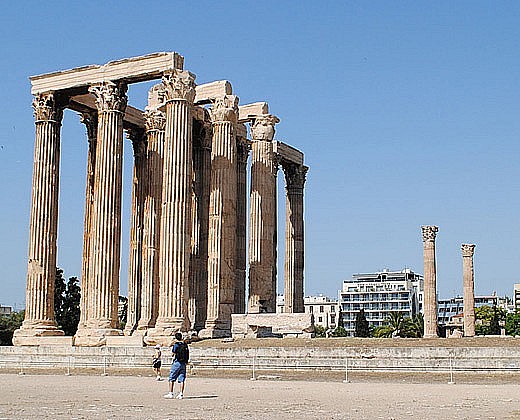
Embarking on an Athens historical tour is akin to stepping into a living museum of antiquity and modernity intertwined. As the cradle of Western civilization, Athens is a city where ancient wonders coexist harmoniously with contemporary life. The tour typically begins with the awe-inspiring Acropolis, a symbol of Greece’s cultural and architectural prowess, crowned by the majestic Parthenon temple dedicated to Athena, the goddess of wisdom. Walking through the Propylaea gateway and exploring the Erechtheion with its iconic Caryatids offers a glimpse into the golden age of Athens. Descending from the Acropolis, the tour often leads to the ancient Agora, once the heart of Athenian democracy and agora of ideas, where philosophers like Socrates and Plato engaged in intellectual discourse. The Temple of Olympian Zeus, Hadrian’s Arch, and the Panathenaic Stadium, where the first modern Olympics were held, are other highlights that add layers to Athens’ historical narrative. A guided Athens historical tour not only unveils the architectural splendors of the past but also delves into the myths, legends, and philosophical heritage that continue to resonate in the vibrant streets of Greece’s capital.
Highlights of the tour (Acropolis, Parthenon, Ancient Agora, etc.)
The Athens historical tour is filled with captivating highlights that showcase the city’s rich cultural heritage and ancient wonders. The tour typically begins with a visit to the iconic Acropolis, a towering citadel perched above the city, where visitors are greeted by the breathtaking Parthenon. This magnificent temple, dedicated to the goddess Athena, is a marvel of ancient Greek architecture, adorned with intricate sculptures and columns that reflect the city’s golden age.
As the tour progresses, participants explore the Ancient Agora, once the bustling marketplace and political center of ancient Athens. Here, they can walk among the ruins of temples, stoas, and monuments, gaining insight into daily life and civic activities in ancient Greece. The Temple of Hephaestus, the Stoa of Attalos, and the Agora Museum are among the key attractions that bring the agora’s history to life.
Additionally, the tour often includes visits to other significant sites such as the Temple of Olympian Zeus, a colossal temple dedicated to the king of the gods, and Hadrian’s Arch, a monumental gateway that served as a symbolic entrance to the city. Exploring these landmarks provides a comprehensive understanding of Athens’ architectural, religious, and political heritage, making the historical tour a memorable journey through millennia of history and culture.
Read more About Historical Tours in Athens
Delphi Day Trip
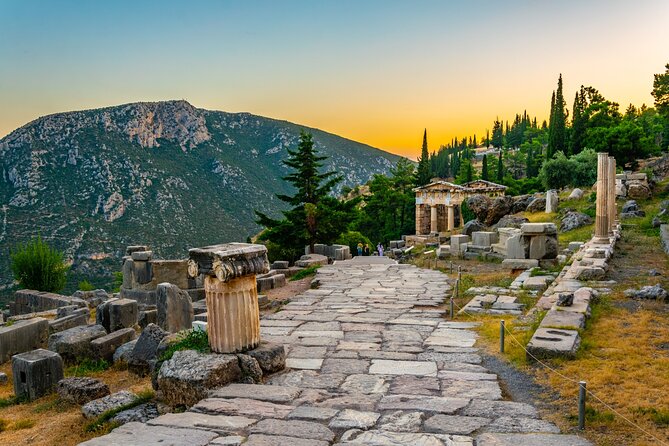
A Delphi day trip is a captivating journey into the mystical heart of ancient Greece, where myth and history intertwine amidst breathtaking natural scenery. Situated on the slopes of Mount Parnassus, Delphi was revered as the center of the world in Greek mythology and was home to the famous Oracle of Delphi, consulted by ancient leaders and seekers of wisdom. The day trip typically begins with a scenic drive through the rugged landscape of central Greece, offering panoramic views of olive groves, vineyards, and the picturesque countryside. Upon arrival in Delphi, visitors are greeted by the imposing ruins of the Temple of Apollo, where the oracle delivered prophetic messages. Exploring the archaeological site reveals the intricacies of ancient religious practices, including the Tholos of Delphi and the Sanctuary of Athena Pronaia.
The Delphi day trip also includes a visit to the Delphi Archaeological Museum, housing a remarkable collection of artifacts, statues, and treasures unearthed from the site. Highlights of the museum include the Charioteer of Delphi, a masterpiece of ancient Greek bronze sculpture, and the Sphinx of Naxos. As visitors wander through the museum’s galleries, they gain deeper insights into the religious beliefs, artistry, and cultural significance of Delphi in antiquity.
Additionally, the day trip allows time for leisurely strolls through the modern village of Delphi, where charming shops, cafes, and panoramic viewpoints await. Whether marveling at the archaeological wonders, pondering the mysteries of the oracle, or simply enjoying the serene beauty of Mount Parnassus, a Delphi day trip offers a memorable immersion into Greece’s ancient past and natural splendor.
Description of Delphi’s ancient sanctuary and Oracle of Delphi
Delphi’s ancient sanctuary and Oracle of Delphi are legendary components of Greece’s historical and mythical tapestry, drawing visitors into the enigmatic world of ancient prophecy and divine communication. Situated on the southwestern slope of Mount Parnassus, the sanctuary of Delphi was dedicated to the god Apollo, known for his association with music, prophecy, and healing. It was here, amidst the serene landscape of olive groves and mountains, that the Oracle of Delphi held sway as the voice of Apollo, offering cryptic yet influential pronouncements that shaped the course of ancient Greek politics, warfare, and culture.
The centerpiece of Delphi’s sanctuary is the Temple of Apollo, a grand structure where the oracle delivered her prophecies. The temple’s architecture, adorned with Doric columns and intricate carvings, reflects the religious significance and artistic achievements of ancient Greece. Adjacent to the temple is the Sacred Way, a processional route lined with treasuries, monuments, and votive offerings from Greek city-states and rulers, showcasing the wealth and devotion of Delphi’s patrons.
The Oracle of Delphi, often referred to as the Pythia, was a priestess chosen to channel Apollo’s divine wisdom. Seekers from across the ancient world, including kings, generals, and ordinary citizens, journeyed to Delphi to seek guidance on matters of war, politics, colonization, and personal affairs. The oracle’s cryptic responses, delivered in a trance-like state, were interpreted by priests and consultants, shaping decisions and actions with profound consequences.
Exploring Delphi’s ancient sanctuary and Oracle of Delphi allows visitors to immerse themselves in the mystical aura of antiquity, contemplating the intersection of myth, religion, and human ambition. The site’s archaeological remains, including the ruins of the temple, treasuries, theater, and stadium, offer glimpses into a bygone era of spiritual reverence and cultural significance. Delphi’s enduring allure lies not only in its historical importance but also in its enduring mystery, inviting modern travelers to ponder the timeless quest for wisdom and insight.
Exploration of the Temple of Apollo and other archaeological sites
Exploring the Temple of Apollo and other archaeological sites in Delphi is a captivating journey through ancient Greece’s religious and cultural heritage. The Temple of Apollo stands as the focal point of Delphi’s sanctuary, its Doric columns and majestic architecture serving as a testament to the reverence and devotion accorded to the god of prophecy. As visitors approach the temple, they are greeted by the remnants of a once-grand structure that housed the enigmatic Oracle of Delphi, where seekers from far and wide sought answers to life’s most pressing questions.
Venturing beyond the Temple of Apollo, the archaeological exploration of Delphi unveils a treasure trove of historical marvels. The Sacred Way, a pathway lined with votive offerings and monuments, leads travelers on a symbolic journey of spiritual significance. Along this route, they encounter the Treasury of the Athenians, a stunning example of ancient Greek architecture adorned with intricate sculptures and reliefs depicting mythological scenes.
Further exploration reveals the Theater of Delphi, an ancient amphitheater nestled into the mountainside, where dramatic performances and musical competitions once enthralled audiences. Nearby, the Stadium of Delphi offers a glimpse into the athletic contests held during the Pythian Games, honoring Apollo and showcasing ancient Greek athleticism and prowess.
The archaeological sites of Delphi also include the Tholos of Delphi, a circular building of mysterious purpose, and the Sanctuary of Athena Pronaia, with its iconic Tholos and remnants of smaller temples dedicated to the goddess Athena. These sites collectively paint a vivid picture of Delphi’s importance as a religious center, cultural hub, and political oracle in the ancient world.
As visitors traverse the pathways of Delphi’s archaeological sites, they are transported back in time, imagining the rituals, ceremonies, and debates that once animated this sacred space. The exploration of the Temple of Apollo and other sites in Delphi offers a profound connection to Greece’s rich heritage, inviting reflection on the enduring legacy of ancient wisdom and spiritual inquiry.
Cultural and religious significance of Delphi in ancient Greece
Delphi held immense cultural and religious significance in ancient Greece, earning a reputation as the “navel of the world” and a sacred sanctuary dedicated to the god Apollo. Its influence extended far beyond its physical boundaries, shaping the beliefs, practices, and political decisions of Greek city-states and individuals alike.
At the heart of Delphi’s cultural significance was the Oracle of Delphi, believed to be the conduit through which the god Apollo communicated his divine will and foresight. The oracle, often a respected priestess known as the Pythia, delivered enigmatic prophecies that were sought by kings, generals, philosophers, and commoners seeking guidance on matters of war, governance, exploration, and personal dilemmas. The oracle’s pronouncements were regarded with reverence and often determined the course of significant events, making Delphi a spiritual and political epicenter of the ancient world.
Delphi’s religious significance stemmed from its association with Apollo, the god of prophecy, music, healing, and enlightenment. The Temple of Apollo at Delphi served as the focal point of worship, where elaborate rituals, sacrifices, and festivals honored the deity and sought his favor. Pilgrims from across Greece and beyond made arduous journeys to Delphi to pay homage to Apollo, seeking blessings, purification, and answers to life’s mysteries.
Beyond its religious functions, Delphi played a crucial role in fostering cultural exchange and intellectual pursuits. The Pythian Games, held every four years in honor of Apollo, featured athletic competitions, musical performances, and artistic displays that brought together artists, athletes, and scholars from diverse backgrounds. The Delphic Oracle’s reputation for wisdom and impartiality also attracted renowned thinkers such as Socrates, Plato, and Herodotus, who sought to unravel the mysteries of human existence and divine insight.
Delphi’s cultural and religious significance endured through centuries of Greek history, even as political landscapes shifted and empires rose and fell. Its influence extended into the Roman period, with emperors and statesmen continuing to consult the oracle and honor Apollo’s sanctuary. Although Delphi eventually declined in prominence with the rise of Christianity and the waning of ancient pagan beliefs, its legacy as a center of spiritual enlightenment, cultural celebration, and divine communication remains indelible in the annals of Greek civilization.
Mycenae and Epidaurus Tour
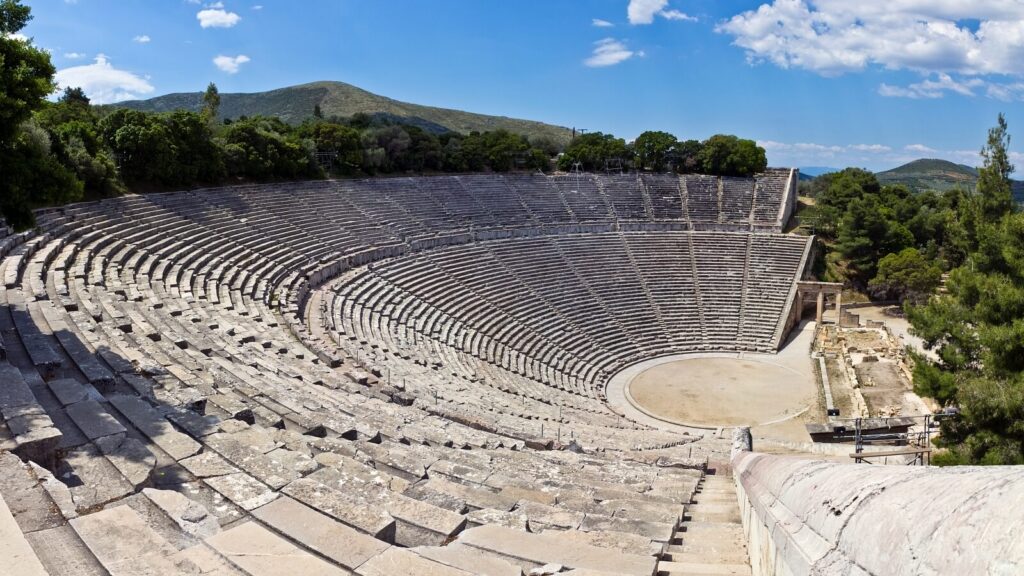
Embark on a captivating journey through ancient Greece with a Mycenae and Epidaurus tour, where history, myth, and architectural marvels converge to tell tales of a bygone era. The tour begins with a visit to Mycenae, a fortified citadel steeped in the legendary exploits of heroes like Agamemnon and the epic narratives of Homer’s Iliad and Odyssey. As you approach the imposing Lion Gate, adorned with its iconic relief sculpture, you’ll step into a world of Mycenaean power and sophistication.
Exploring Mycenae’s archaeological wonders, including the Treasury of Atreus (a monumental tholos tomb), the Cyclopean Walls, and the Royal Palace complex, reveals the architectural prowess and cultural richness of this ancient civilization. The myths and history intertwine as you learn about the Mycenaeans’ role in shaping Greek culture and their connections to the Trojan War and the broader Aegean world.
Continuing the tour, you’ll journey to Epidaurus, renowned for its ancient theater and healing sanctuary dedicated to the god of medicine, Asclepius. The Epidaurus theater stands as a masterpiece of ancient Greek theater architecture, renowned for its acoustics and harmonious design. Imagine the echoes of performances echoing through the millennia as you stand amidst the well-preserved seats and stage.
The tour also includes a visit to the Sanctuary of Asclepius, where pilgrims sought healing and divine guidance. Explore the Tholos of Epidaurus, an elegant circular building that served as a key part of the sanctuary, and learn about ancient medical practices, spiritual rituals, and the interconnectedness of mind, body, and spirit in Greek culture.
Through the Mycenae and Epidaurus tour, you’ll unravel the layers of ancient Greek history, from legendary heroes and myths to architectural achievements and spiritual beliefs. It’s a journey that transports you back in time, offering insights into the enduring legacy of Mycenae and the therapeutic traditions of Epidaurus, all against the backdrop of Greece’s scenic landscapes and cultural heritage.
Overview of Mycenae’s Fortified Citadel and Royal Tombs:
Mycenae’s fortified citadel stands as a testament to the military prowess and cultural sophistication of the Mycenaean civilization. Encircled by massive Cyclopean walls constructed with massive limestone blocks, the citadel commands a strategic position overlooking the surrounding landscape. The legendary Lion Gate, adorned with relief sculptures depicting lionesses, serves as the monumental entrance to this ancient stronghold, evoking tales of heroes and epic adventures.
Within the citadel, visitors discover the remnants of the Royal Palace complex, featuring grand chambers, storerooms, and administrative spaces that showcase the Mycenaeans’ architectural ingenuity and organizational skills. The Treasury of Atreus, also known as the Tomb of Agamemnon, is a striking tholos tomb characterized by its massive corbelled dome and intricate stonework, reflecting the Mycenaeans’ reverence for their deceased rulers and their belief in the afterlife.
Visit to Epidaurus and Its Well-Preserved Ancient Theater:
Epidaurus, nestled amidst scenic countryside, is renowned for its well-preserved ancient theater, a masterpiece of Greek theater architecture. The theater’s design, with its impeccable acoustics and harmonious proportions, creates an immersive experience for visitors, allowing them to imagine the performances that once graced its stage during ancient festivals in honor of the god Asclepius.
As visitors explore the theater’s tiers of limestone seats and orchestra area, they gain insights into ancient Greek dramatic arts, musical performances, and communal gatherings that were integral to cultural and religious life. The surrounding Sanctuary of Asclepius, dedicated to healing and wellness, offers further glimpses into ancient medical practices, spiritual rituals, and the interconnectedness of mind, body, and spirit in Greek society.
Understanding the Mycenaean Civilization and Its Influence:
The Mycenaean civilization, with its centralized citadels, monumental architecture, and rich cultural heritage, exerted a profound influence on the development of ancient Greece and subsequent civilizations. Through the Mycenae and Epidaurus tour, visitors gain a deeper understanding of Mycenaean society, economy, religion, and political organization.
The citadel of Mycenae provides insights into Mycenaean military strategies, trade networks, and urban planning, highlighting their role as a dominant power in the Aegean region during the Late Bronze Age. The discovery of royal tombs, such as the Treasury of Atreus, offers clues about Mycenaean burial customs, elite status, and artistic achievements, including exquisite gold jewelry and ceremonial artifacts.
The tour also sheds light on the Mycenaeans’ cultural legacy, including their contributions to art, literature, language (Linear B script), and mythology. Mycenaean myths and legends, immortalized in Homer’s epics and Greek folklore, continue to resonate in Western literature and popular culture, showcasing the enduring impact of this ancient civilization on global heritage.
Olympia Day Tour
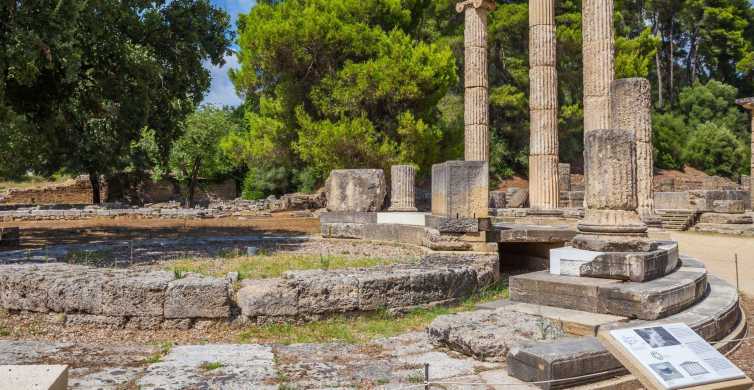
Embark on a transformative journey through ancient athletic prowess and cultural heritage with an Olympia day tour, where the birthplace of the Olympic Games comes alive amidst serene landscapes and monumental ruins. The tour begins with a pilgrimage to the archaeological site of Olympia, nestled in the picturesque Peloponnese region of Greece. Here, visitors are transported back in time to a sacred sanctuary dedicated to Zeus, the king of the gods, and the site of the original Olympic Games, held in honor of the deities and showcasing the physical and spiritual prowess of ancient athletes.
As visitors explore the vast archaeological complex of Olympia, they encounter iconic landmarks such as the Temple of Zeus, once housing the renowned gold and ivory statue of Zeus by the sculptor Phidias, one of the Seven Wonders of the Ancient World. The Temple of Hera, dedicated to Zeus’s consort, offers insights into ancient religious practices and rituals, while the ancient stadium, where athletes competed in footraces and chariot races during the Olympic Games, evokes the spirit of ancient competition and human achievement.
The tour also includes a visit to the Olympia Archaeological Museum, where a wealth of artifacts, sculptures, and Olympic memorabilia are displayed, including the exquisite Hermes of Praxiteles statue and the Nike of Paionios. These treasures provide a deeper understanding of ancient Greek artistry, athleticism, and cultural values, highlighting the enduring legacy of the Olympic Games as a symbol of unity, sportsmanship, and international camaraderie.
Moreover, the Olympia day tour offers moments of reflection and awe amidst the tranquil surroundings of the Altis, the sacred grove of Zeus, where ancient olive trees and ruins stand as testament to centuries of human endeavor and spiritual devotion. Whether marveling at the grandeur of ancient temples, imagining the cheers of ancient spectators in the stadium, or contemplating the ideals of excellence and fair play embodied by the Olympic Games, the Olympia day tour is a transformative experience that celebrates Greece’s timeless contributions to global culture and sporting tradition.
Journey to Olympia, birthplace of the Olympic Games
Embark on an inspiring journey to Olympia, the revered birthplace of the Olympic Games, where ancient traditions of athletic prowess and cultural celebration converge in a tranquil setting steeped in history. Nestled in the verdant landscape of the Peloponnese region in Greece, Olympia serves as a testament to the enduring spirit of human achievement and camaraderie that has transcended centuries.
The journey to Olympia begins with a pilgrimage to the archaeological site, known as the Altis, a sacred sanctuary dedicated to Zeus, the father of the gods, and Hera, his consort. Here, amidst the remnants of ancient temples, statues, and athletic facilities, visitors step into the world of ancient Greek athletes who once gathered to compete in honor of the gods. The Altis unfolds like a time capsule, offering glimpses into the religious rituals, sporting events, and cultural festivities that defined the Olympic Games in antiquity.
As visitors wander through the hallowed grounds of Olympia, they encounter iconic landmarks such as the Temple of Zeus, a monumental structure that once housed the magnificent gold and ivory statue of Zeus by Phidias. The nearby Temple of Hera, with its Doric columns and serene surroundings, evokes the reverence and devotion of ancient worshippers. The ancient stadium, where athletes sprinted to victory and chariots thundered in competition, resonates with echoes of cheers and determination from centuries past.
Beyond the archaeological site, the journey to Olympia includes a visit to the Olympia Archaeological Museum, where a treasure trove of artifacts, sculptures, and Olympic memorabilia awaits. From ancient athletic equipment and statues of victorious athletes to votive offerings and Olympic medals, the museum’s exhibits offer a comprehensive glimpse into the rich heritage and cultural significance of the Olympic Games.
The journey to Olympia is not just a physical pilgrimage but a profound exploration of human potential, sportsmanship, and the enduring legacy of ancient Greek ideals. It is a testament to the universal appeal of the Olympic Games as a platform for unity, peace, and the pursuit of excellence across generations and cultures.
Exploration of the archaeological site, temples, and athletic facilities
Exploring the archaeological site, temples, and athletic facilities of Olympia is a captivating journey into the heart of ancient Greek culture, athleticism, and religious devotion. As visitors traverse the sacred grounds of the Altis, the central sanctuary of Olympia, they are immersed in a world where gods were revered, athletes competed, and cultural exchange flourished.
The exploration begins with a stroll through the vast expanse of the Altis, surrounded by towering remnants of ancient temples, monuments, and athletic facilities. The Temple of Zeus, a colossal Doric temple once housing the renowned statue of Zeus, draws awe with its grandeur and architectural splendor. Nearby, the Temple of Hera, dedicated to Zeus’s consort, stands as a testament to ancient religious practices and reverence for the divine.
Continuing the exploration, visitors encounter the Palaestra, an ancient gymnasium where athletes trained and prepared for the Olympic Games. The Gymnasion, a site for philosophical and intellectual pursuits, offers insights into ancient Greek education and the pursuit of knowledge. The Bouleuterion, or council house, reflects the democratic ideals and governance structures of ancient Olympia.
The highlight of the exploration is the ancient stadium, where athletes from across the Greek world competed in footraces, wrestling, boxing, and chariot races during the Olympic Games. Walking along the track and sitting in the marble seats, visitors can almost hear the echoes of cheers and the roar of spectators that once filled the stadium with excitement and anticipation.
Beyond the athletic facilities, the archaeological site of Olympia reveals a rich tapestry of ancient life, from the Treasuries of various city-states showcasing their offerings to the grand Nymphaeum, a monumental fountain dedicated to the nymphs. The Leonidaion, a guesthouse for athletes and dignitaries, and the Philippeion, a circular monument honoring Alexander the Great’s family, add layers to Olympia’s historical and cultural significance.
As visitors explore the archaeological site, temples, and athletic facilities of Olympia, they delve into the essence of ancient Greek ideals—physical prowess, spiritual devotion, intellectual inquiry, and communal celebration. It is a journey that transcends time, offering a profound connection to the timeless legacy of Olympia as a beacon of human excellence and cultural heritage.
Museum visit to learn about the history of the Olympics
Embarking on a museum visit in Olympia offers an immersive opportunity to delve deep into the rich history and evolution of the Olympic Games, tracing their origins from ancient Greece to the modern-day global phenomenon. The museum, nestled amidst the serene surroundings of Olympia, serves as a treasure trove of artifacts, sculptures, and interactive exhibits that unravel the fascinating story of the Olympics.
Upon entering the museum, visitors are greeted by displays showcasing the ancient origins of the Olympic Games, dating back to 776 BCE. Exhibits feature ancient athletic equipment, such as discuses, javelins, and weights, giving insight into the sports and competitions that captivated the ancient Greeks. A highlight of the museum is the collection of Olympic victor statues, depicting victorious athletes in various sporting disciplines and offering a glimpse into the glory and honor associated with Olympic triumph.
As visitors progress through the museum, they encounter exhibits detailing the evolution of the Olympic Games over centuries, including the revival of the modern Olympics in 1896. Photographs, documents, and memorabilia from past Olympic Games illuminate the global impact and cultural significance of the Olympics, showcasing moments of unity, sportsmanship, and athletic excellence from around the world.
Interactive displays and multimedia presentations engage visitors of all ages, allowing them to experience the thrill of Olympic competition, explore the values of fair play and cooperation, and understand the role of the Olympics in promoting peace and understanding among nations. Virtual reality simulations and interactive games offer a hands-on experience, immersing visitors in the excitement and challenges of Olympic sports.
Moreover, the museum visit offers insights into the cultural and societal aspects of the Olympics, including the role of women in sports, the Olympic torch relay, and the legacy of Olympic host cities. Exhibits also highlight the environmental and sustainability initiatives of the modern Olympics, emphasizing the Games’ commitment to positive global impact and legacy.
Overall, the museum visit in Olympia is a journey of discovery and inspiration, celebrating the enduring spirit of the Olympic Games as a symbol of unity, athleticism, and human achievement across generations and continents. It fosters a deeper appreciation for the history, values, and cultural significance of the Olympics, leaving visitors inspired by the Olympic ideals of excellence, friendship, and respect.
Crete Historical Tour
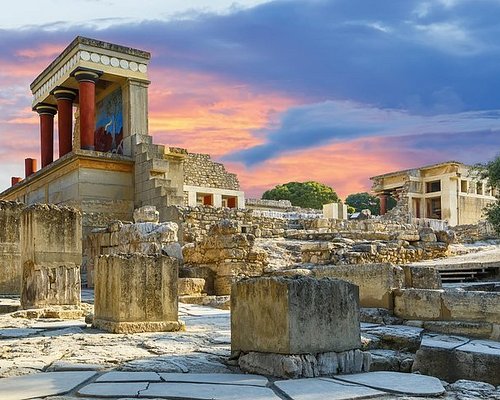
Embark on a captivating Crete historical tour that unravels the ancient mysteries and cultural richness of Greece’s largest island. Crete, steeped in myth and history, is a treasure trove of archaeological wonders, Minoan civilization, and natural beauty waiting to be explored. The historical tour begins with a visit to the legendary Palace of Knossos, the seat of power of the Minoan civilization and the mythical labyrinth of King Minos and the Minotaur. As visitors wander through the labyrinthine corridors, grand chambers, and vibrant frescoes of Knossos, they are transported back to the Bronze Age, discovering the advanced architecture, artistry, and maritime prowess of the ancient Minoans.
Continuing the journey, the tour ventures to other significant Minoan sites, such as the Palace of Phaistos, renowned for its massive structure and enigmatic Phaistos Disc, an ancient script that continues to puzzle scholars. The archaeological site of Gortyna reveals the remnants of a once-thriving ancient city, including the famous Law Code inscribed on stone, offering insights into Minoan governance and legal systems.
The historical tour also includes a visit to the Archaeological Museum of Heraklion, where a vast collection of Minoan artifacts, sculptures, and pottery illuminate the daily life, religious practices, and artistic achievements of the Minoans. Treasures such as the Snake Goddess figurines, bull-leaping frescoes, and intricate pottery designs showcase the cultural richness and artistic sophistication of Minoan civilization.
Moreover, the Crete historical tour delves into the island’s Byzantine and Venetian heritage, with visits to medieval castles, Byzantine churches adorned with frescoes, and the charming old towns of Rethymno and Chania. Exploring the Venetian fortress of Heraklion and the ancient city of Aptera offers glimpses into Crete’s tumultuous history of conquests, trade, and cultural exchange.
The tour also celebrates Crete’s natural beauty, from stunning beaches and rugged landscapes to picturesque villages nestled in the mountains. Whether marveling at ancient ruins, admiring Byzantine art, or savoring Cretan cuisine and hospitality, the Crete historical tour promises an unforgettable journey through time, culture, and myth on this captivating Mediterranean island.
Visit to the Palace of Knossos and other Minoan sites on Crete
The Crete historical tour begins with a mesmerizing visit to the Palace of Knossos, an iconic Minoan site that serves as a window into the ancient past of Crete. As visitors explore the labyrinthine corridors, intricate frescoes, and grand chambers of Knossos, they unravel the mysteries of Minoan civilization. The palace, believed to be the mythical labyrinth of King Minos and the Minotaur, showcases the advanced architectural techniques, vibrant artwork, and sophisticated urban planning of the Minoans. Beyond Knossos, the tour includes visits to other significant Minoan sites on Crete, such as the Palace of Phaistos and the archaeological site of Gortyna, offering a comprehensive glimpse into the majesty and influence of Minoan culture on the island.
Insights into the Minoan civilization, culture, and mythology
Delving deeper into the Crete historical tour, participants gain profound insights into the Minoan civilization, its culture, and mythology. The Minoans, known for their maritime prowess, seafaring trade networks, and artistic achievements, left behind a legacy of vibrant frescoes, intricate pottery, and religious rituals that reflect their cosmopolitan society. Exploring the Minoan ruins and artifacts offers a glimpse into their religious beliefs, including reverence for nature, fertility goddesses such as the iconic Snake Goddess figurines, and rituals like bull-leaping depicted in frescoes. The tour also delves into Minoan mythology, including tales of gods and goddesses, such as Zeus, Poseidon, and the labyrinth-dwelling Minotaur, adding depth to the understanding of Minoan culture and symbolism.
Importance of Crete in ancient Mediterranean trade and culture
The Crete historical tour highlights the importance of Crete in ancient Mediterranean trade and culture, showcasing the island’s strategic location as a crossroads of civilizations. Crete’s maritime prowess and flourishing trade networks allowed the Minoans to establish connections with Egypt, Mesopotamia, Greece, and other Mediterranean cultures, facilitating the exchange of goods, ideas, and artistic influences. The tour explores the remnants of Minoan ports, such as Kommos and Zakros, revealing Crete’s role as a hub of commerce, cultural diffusion, and technological innovation in the ancient world. Additionally, the tour sheds light on Crete’s contributions to Mediterranean cuisine, agricultural practices, and craftsmanship, highlighting the enduring legacy of Minoan civilization and Crete’s significance in shaping the cultural tapestry of the Mediterranean region.
Read more about Historical Tours in Crete
Santorini Archaeological Tour
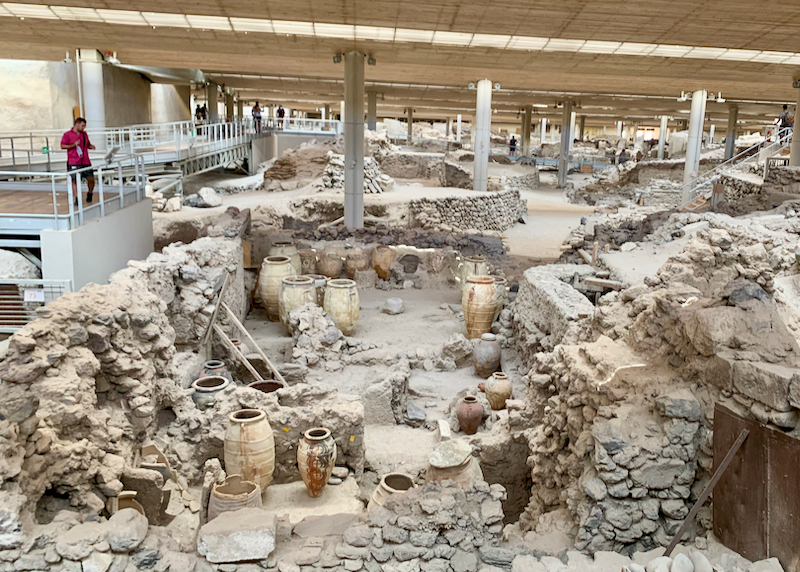
Embark on an enchanting Santorini archaeological tour that unveils the ancient wonders and cultural heritage of this captivating Aegean island. Santorini, with its stunning vistas, volcanic landscapes, and deep-rooted history, is a treasure trove of archaeological sites that offer glimpses into the island’s rich past. The archaeological tour begins with a visit to the ancient city of Akrotiri, often referred to as the “Minoan Pompeii” due to its remarkably preserved ruins from the Bronze Age Minoan civilization.
As visitors explore the excavated streets, buildings, and frescoes of Akrotiri, they step back in time to a bustling prehistoric settlement that thrived before the catastrophic eruption of the Thera volcano. The well-preserved structures, advanced drainage systems, and intricate artworks depict a sophisticated society with ties to the wider Aegean world, showcasing the artistic, architectural, and technological achievements of the Minoans.
Continuing the tour, participants delve into the archaeological site of Ancient Thera, perched atop Mesa Vouno mountain. This ancient city, inhabited by various civilizations throughout history, offers panoramic views of the island and the Aegean Sea. The ruins of temples, houses, and public buildings provide insights into the daily life, religious practices, and cultural influences that shaped Santorini’s history.
The Santorini archaeological tour also includes a visit to the Museum of Prehistoric Thera in Fira, where a remarkable collection of artifacts from Akrotiri and other sites are displayed. The museum’s exhibits, including pottery, tools, figurines, and frescoes, offer a deeper understanding of Minoan civilization, trade networks, and artistic expression. Highlights of the museum include the iconic “Boxer Fresco” and the “Spring Fresco,” which showcase the vibrancy and beauty of Minoan art.
Moreover, the tour may explore other archaeological sites on Santorini, such as the ancient city of Thera in Kamari, the Byzantine Castle of Skaros in Imerovigli, or the archaeological site of Ancient Elefsina in Akrotiri. Each site contributes to the mosaic of Santorini’s history, from ancient civilizations to medieval settlements, showcasing the island’s enduring allure as a crossroads of cultures and a beacon of archaeological fascination in the Aegean Sea.
Overall, the Santorini archaeological tour promises an immersive and enlightening journey through the island’s ancient past, offering a deeper appreciation for Santorini’s cultural heritage, geological marvels, and timeless allure as a destination steeped in history and mystique.
Discovery of Akrotiri, a Minoan Bronze Age settlement preserved in ash
The Santorini archaeological tour unfolds with the fascinating discovery of Akrotiri, a Minoan Bronze Age settlement frozen in time by the volcanic ash from the Thera eruption. Exploring Akrotiri is akin to stepping into a time capsule of ancient Minoan life, where well-preserved buildings, streets, and artworks offer a glimpse into a sophisticated civilization that thrived thousands of years ago. The advanced urban planning, intricate frescoes depicting daily activities and religious scenes, and evidence of trade networks highlight the cultural and artistic achievements of the Minoans. Akrotiri’s preservation in ash has not only provided invaluable insights into Minoan society but also sparked intrigue and fascination about the ancient world buried beneath Santorini’s volcanic layers.
Visit to the Museum of Prehistoric Thera for artifacts and history
The Santorini archaeological tour includes a captivating visit to the Museum of Prehistoric Thera, located in Fira, where a treasure trove of artifacts and historical narratives awaits. The museum’s exhibits showcase the rich heritage of Santorini, with a focus on the Minoan civilization of Akrotiri and other archaeological sites on the island. Visitors can marvel at pottery, tools, figurines, and frescoes excavated from Akrotiri, gaining a deeper understanding of Minoan daily life, religious beliefs, and artistic expressions. The museum’s collection, including iconic pieces like the “Boxer Fresco” and the “Spring Fresco,” offers a comprehensive journey through Santorini’s prehistoric past, illuminating its significance in the wider Aegean world.
Understanding the volcanic history and cultural heritage of Santorini
Delving into the volcanic history and cultural heritage of Santorini is an integral part of the archaeological tour, as participants gain a holistic perspective on the island’s evolution and allure. Santorini’s volcanic landscape, shaped by the cataclysmic Thera eruption around 1600 BCE, serves as a dramatic backdrop to its archaeological sites and historical narratives. The tour provides insights into the geological forces that have shaped Santorini’s unique caldera, rugged cliffs, and volcanic beaches, creating a surreal and awe-inspiring environment. Moreover, the tour delves into Santorini’s cultural heritage, from ancient civilizations like the Minoans to subsequent settlements, Byzantine influences, and Venetian rule, showcasing the island’s enduring legacy as a crossroads of cultures and a beacon of archaeological fascination in the Aegean Sea.
Thessaloniki Byzantine Tour
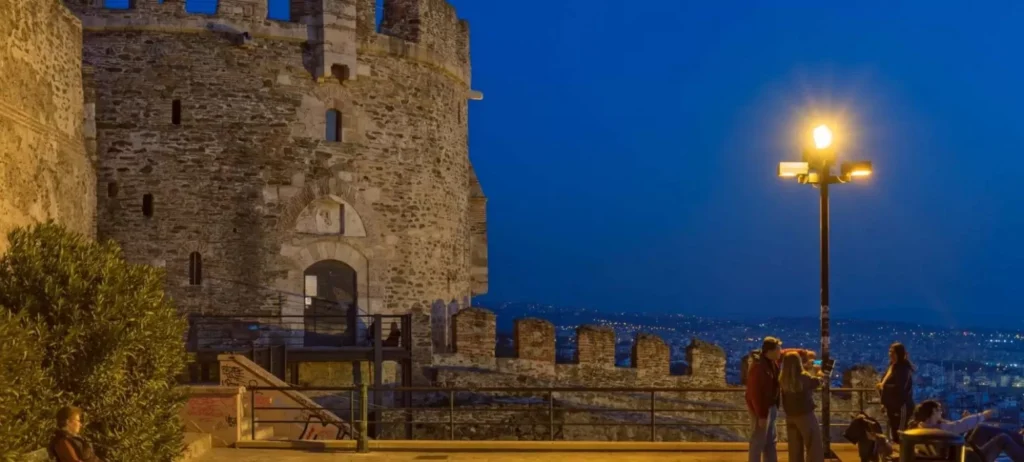
Embark on a captivating journey through the rich Byzantine heritage of Thessaloniki with a dedicated Byzantine tour that unveils the city’s historical, cultural, and architectural treasures. Thessaloniki, often referred to as the “co-capital” of the Byzantine Empire, boasts a wealth of Byzantine monuments, churches, and artifacts that offer insights into its illustrious past as a center of Byzantine art, religion, and politics.
The Thessaloniki Byzantine tour commences with a visit to the UNESCO-listed Paleochristian and Byzantine Monuments of Thessaloniki, where participants can marvel at iconic structures such as the Rotunda of Galerius, an ancient Roman monument later converted into a Byzantine church. The Rotunda’s impressive dome, intricate mosaics, and historical significance as a testament to the city’s Christian heritage make it a must-see attraction on the tour.
Continuing the exploration, the tour delves into Thessaloniki’s Byzantine churches, renowned for their architectural splendor and religious significance. The Church of Hagia Sophia, not to be confused with its namesake in Istanbul, showcases exquisite Byzantine mosaics and frescoes that narrate biblical stories and saints’ lives with stunning artistic detail. The Church of Panagia Chalkeon and the Church of St. Demetrios, dedicated to the city’s patron saint, also offer captivating glimpses into Byzantine religious art and devotion.
The Thessaloniki Byzantine tour further immerses participants in the city’s Byzantine legacy through visits to museums such as the Museum of Byzantine Culture, where a comprehensive collection of Byzantine artifacts, icons, manuscripts, and relics provide a deeper understanding of Thessaloniki’s Byzantine era. The museum’s exhibits offer insights into daily life, artistic traditions, and historical events that shaped Byzantine Thessaloniki, highlighting its importance as a cultural and intellectual center during the Byzantine Empire.
Moreover, the tour may include stops at fortified walls, archaeological sites, and Byzantine baths, showcasing Thessaloniki’s strategic importance, urban development, and architectural innovations during the Byzantine period. Participants also have the opportunity to explore the vibrant markets, squares, and neighborhoods of modern Thessaloniki, where echoes of Byzantine history and culture blend with contemporary life, creating a dynamic and layered urban experience.
Overall, the Thessaloniki Byzantine tour promises an enlightening and immersive journey through the city’s Byzantine legacy, offering a deeper appreciation for its historical significance, artistic achievements, and enduring cultural heritage in the heart of Greece’s northern region.
Exploration of Thessaloniki’s Byzantine churches and monuments
The Thessaloniki Byzantine tour begins with an immersive exploration of the city’s Byzantine churches and monuments, each telling a unique story of religious devotion, architectural brilliance, and artistic expression. Participants have the opportunity to visit iconic churches such as the Church of Hagia Sophia, adorned with breathtaking mosaics and frescoes that depict scenes from the Bible and the lives of saints. The Church of Panagia Chalkeon, known for its intricate stonework and Byzantine aesthetics, provides a glimpse into Byzantine architectural ingenuity and religious symbolism. These churches, along with others scattered throughout the city, offer a profound insight into Thessaloniki’s spiritual and artistic heritage during the Byzantine era.
Visit to the Church of Agios Demetrios, Rotunda of Galerius, and Byzantine Walls
The Thessaloniki Byzantine tour includes a visit to significant landmarks that showcase the city’s Byzantine splendor. Participants have the privilege of exploring the Church of Agios Demetrios, dedicated to the city’s patron saint and adorned with exquisite mosaics and religious artifacts. The Rotunda of Galerius, a monumental structure originally built as a Roman mausoleum and later transformed into a Byzantine church, captivates visitors with its grandeur and historical significance. The tour also takes participants to admire Thessaloniki’s Byzantine Walls, a testament to the city’s strategic fortifications and defensive architecture during the Byzantine period, highlighting its role as a key stronghold in the Byzantine Empire.
Appreciation of Thessaloniki’s role in Byzantine history and culture
Throughout the Thessaloniki Byzantine tour, participants gain a profound appreciation for the city’s pivotal role in Byzantine history and culture. Thessaloniki’s strategic location as a crossroads of trade routes, its vibrant intellectual and artistic scene, and its status as an imperial city of the Byzantine Empire all contribute to its enduring legacy. The tour fosters an understanding of Thessaloniki’s contributions to Byzantine art, architecture, theology, and political dynamics, showcasing its importance as a beacon of Byzantine civilization in the Balkans. Participants leave the tour with a deepened appreciation for Thessaloniki’s heritage and its enduring impact on Byzantine history and culture.
Peloponnese Peninsula Tour
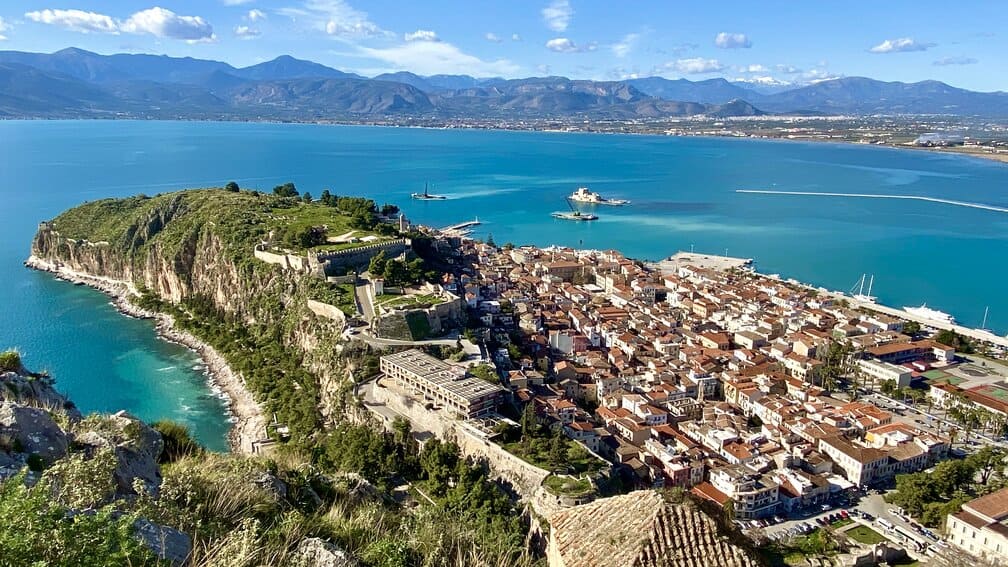
Embark on an unforgettable Peloponnese Peninsula tour, where history, mythology, and natural beauty converge to create a journey through ancient ruins, picturesque landscapes, and legendary sites. The Peloponnese Peninsula, located in southern Greece, is a treasure trove of archaeological wonders, historic cities, and scenic vistas that offer a comprehensive immersion into Greek history and culture.
The Peloponnese Peninsula tour begins with a visit to the ancient city of Corinth, renowned for its strategic location and historical significance. Explore the ruins of ancient Corinth, including the Temple of Apollo, the Agora, and the iconic Corinth Canal, which connects the Gulf of Corinth with the Saronic Gulf, offering panoramic views and engineering marvels.
Continuing the journey, participants venture to Mycenae, the legendary city of Agamemnon and the Mycenaean civilization. Discover the imposing Lion Gate, the Treasury of Atreus (Tomb of Agamemnon), and the ancient walls of Mycenae, which bear witness to the city’s military might and cultural achievements during the Bronze Age.
Next, the tour takes participants to Epidaurus, famous for its ancient theater renowned for its acoustics and architectural perfection. Imagine the echoes of ancient performances as you explore the well-preserved theater and the Sanctuary of Asclepius, where healing rituals and spiritual practices once took place.
The Peloponnese Peninsula tour also includes a visit to Olympia, the birthplace of the Olympic Games and a sacred sanctuary dedicated to Zeus. Marvel at the ancient stadium, the Temple of Zeus, and the archaeological museum, home to exquisite artifacts and statues that highlight the glory of ancient Greek athletics and religious devotion.
As the tour progresses, participants have the opportunity to explore the fortified town of Nafplio, with its Venetian fortress, charming old town, and scenic waterfront. Additionally, visits to the archaeological sites of Mystras, Ancient Messene, and the Byzantine city of Monemvasia offer insights into the region’s medieval and Byzantine heritage, showcasing magnificent churches, palaces, and fortifications.
Throughout the Peloponnese Peninsula tour, participants are immersed in the rich tapestry of Greek history, mythology, and cultural heritage, from ancient civilizations to medieval kingdoms and modern-day charm. It’s a journey that encapsulates the essence of Greece’s past and present, set against a backdrop of stunning landscapes and timeless wonders.
Overview of key ancient sites in the Peloponnese region
The Peloponnese Peninsula tour offers a comprehensive exploration of key ancient sites that showcase the region’s rich history and cultural heritage. Mycenae, the legendary city of Agamemnon, stands as a testament to the Mycenaean civilization’s military prowess and artistic achievements. Visitors marvel at the imposing Lion Gate, the Treasury of Atreus, and the ancient walls that once guarded this powerful citadel.
Epidaurus, renowned for its ancient theater and healing sanctuary dedicated to Asclepius, provides insights into ancient Greek drama, medicine, and religious practices. The well-preserved theater, with its exceptional acoustics, transports visitors to a time of theatrical performances and communal gatherings.
Ancient Corinth, situated at the crossroads of land and sea routes, offers a glimpse into ancient commerce, architecture, and cultural exchange. The ruins of temples, markets, and the Corinth Canal, an engineering marvel connecting two seas, highlight Corinth’s strategic importance in antiquity.
Nafplio, a picturesque town with Venetian fortifications, narrow streets, and a charming old town, serves as a gateway to the Peloponnese’s historical treasures. Visitors can explore the Palamidi Fortress, the Bourtzi water castle, and the Archaeological Museum of Nafplio, immersing themselves in the region’s medieval and modern history.
Historical significance of the Peloponnese in Greek history and mythology
The Peloponnese Peninsula holds immense historical significance in Greek history and mythology, serving as a backdrop to legendary tales, heroic exploits, and pivotal events. According to mythology, the Peloponnese was named after Pelops, a mythical figure and hero of ancient Greece. The region is associated with the Twelve Labors of Hercules, the Trojan War, and the exploits of heroes like Agamemnon, Achilles, and Odysseus.
Historically, the Peloponnese was home to powerful city-states such as Sparta, Corinth, and Argos, which played crucial roles in shaping Greek politics, culture, and warfare. The region witnessed the rise and fall of ancient civilizations, including the Mycenaeans, Spartans, and Byzantines, leaving behind a legacy of architectural marvels, archaeological sites, and cultural traditions.
Architectural and archaeological highlights of the tour
The Peloponnese Peninsula tour is replete with architectural and archaeological highlights that showcase the region’s diverse heritage. From the Cyclopean walls of Mycenae to the well-preserved theater of Epidaurus, visitors encounter masterpieces of ancient Greek architecture and engineering. The Corinth Canal, an engineering feat of the modern era, contrasts with ancient ruins such as the Temple of Apollo in Corinth.
The tour also highlights Byzantine and medieval architecture, seen in the fortified town of Nafplio, the Byzantine city of Mystras, and the medieval castle-town of Monemvasia. These sites feature intricate churches, palaces, and fortifications that reflect the region’s tumultuous history and cultural evolution.
Overall, the Peloponnese Peninsula tour offers a captivating journey through time, combining mythological tales, historical narratives, and architectural wonders to provide a comprehensive understanding of the region’s significance in Greek history and culture.
Conclusion
In Conclusion Historical tours in Greece offer an enriching and immersive experience that delves deep into the country’s rich heritage, ancient civilizations, and cultural legacy. From the majestic ruins of Athens and the mythical birthplace of the Olympic Games in Olympia to the ancient wonders of Delphi, Mycenae, Epidaurus, and the Byzantine treasures of Thessaloniki and the Peloponnese Peninsula, each tour unveils layers of history, mythology, and architectural marvels that define Greece’s timeless allure.
These tours not only showcase Greece’s pivotal role in shaping Western civilization but also provide insights into the achievements, beliefs, and daily life of ancient Greeks. Exploring iconic landmarks such as the Acropolis, Parthenon, Delphi’s ancient sanctuary, Mycenae’s fortified citadel, and Thessaloniki’s Byzantine churches allows visitors to connect with Greece’s past on a profound level, gaining a deeper appreciation for its cultural contributions to the world.
Moreover, historical tours in Greece offer a journey of discovery and enlightenment, where travelers can immerse themselves in the stories of gods and heroes, marvel at ancient art and architecture, and trace the footsteps of ancient philosophers, athletes, and rulers. The importance of these tours extends beyond mere sightseeing, fostering a deeper understanding of humanity’s collective heritage, the evolution of societies, and the enduring legacy of ancient civilizations.
